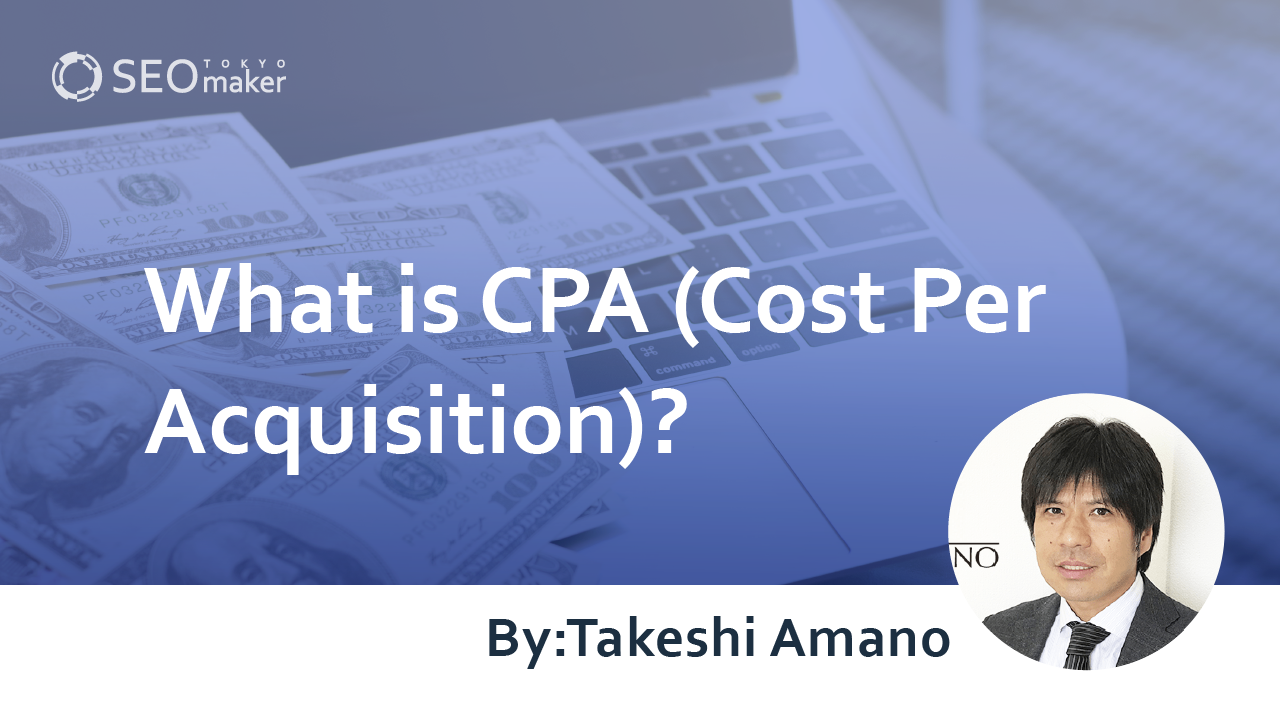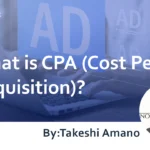What is CPA (Cost Per Acquisition)? Leveraging Advertising Effectiveness for Improvement
contents

One crucial strategy in web marketing is online advertising. In managing these ads, it’s essential to acquire as many conversions (CVs) as possible within a given budget.
The CPA (Cost Per Acquisition) metric is pivotal in ad management. Mastering how to minimize CPA and maximize acquisition efficiency is a key skill for ad managers.
In this article, we’ll explore how to set and improve your CPA.
Understanding CPA
CPA stands for Cost Per Acquisition, referring to the cost incurred to achieve a single conversion—such as an application, brochure request, or inquiry—actions related to customer purchasing behavior.
The Importance of CPA
When managing ads, the ability to maximize conversions within a set budget is crucial. CPA serves as a metric to evaluate the cost-effectiveness of ad operations. For instance, a low CPA indicates efficient ad management, whereas a high CPA suggests costly conversions and low cost-effectiveness.
Regularly calculating and reviewing CPA helps gauge the profitability of advertisements and guides improvements.
Calculating CPA
You can calculate CPA with the following formula.
CPA = Advertising Cost ÷ Number of Conversions
For example, if the advertising cost is 1 million yen and it results in 5,000 conversions, the CPA would be 200 yen.
Consider two campaigns collecting brochure requests:
|
Campaign |
Advertising Cost |
Number of Users Acquired |
CPA |
|
A |
1 million yen |
5,000 people |
200 yen |
|
B |
1 million yen |
2,000 people |
500 yen |
Comparing Campaign A and B, Campaign A has a lower CPA at 200 yen. Since a lower CPA is considered more efficient for advertising, Campaign A can be said to have a higher acquisition efficiency in this case.
Setting a Target CPA
When setting a target CPA, it’s crucial to ensure profitability. The calculation should consider not only the ad spend but also the cost of goods and labor.
Aiming to operate profitable ads is essential; thus, calculating a break-even CPA is a prerequisite. However, CPA targets vary by product, service, and company, and there are limits to how much it can be reduced.
What is Marginal CPA?
Marginal CPA refers to the maximum amount that can be spent to acquire a conversion without incurring a loss.
It can be calculated as below.
Marginal CPA = Sales Price − Cost of Goods − Expenses
For instance, if the sales price is 10,000 yen, the cost of goods is 3,000 yen, and expenses are 2,000 yen, then the marginal CPA would be 5,000 yen. However, using this figure as your operational guide would yield no profit, hence it’s a maximum threshold.
Target CPA
Target CPA is the goal amount to spend per conversion. It is set based on the calculated marginal CPA, determining the proportion of the budget to be spent on advertising.
Target CPA can be calculated as below.
Setting a Target CPA: Target CPA = Marginal CPA – Desired Profit
For instance, if the marginal CPA is 5,000 yen and the desired profit is 2,000 yen, then the target CPA would be 3,000 yen.
Improving CPA
Enhancing the cost-effectiveness of advertisements is essential, and improving the CPA is a critical part of this. There are primarily two ways to improve CPA.
-Increase the number of conversions (CVs).
-Reduce the cost per click.
Ways to Increase Conversion Numbers
To boost conversions, it’s crucial to review and refine the appeal and targeting of your advertisements.
Consider the challenges your target audience faces and the keywords they might use to search for solutions when crafting your ad copy. Designing both the ad copy and the landing pages from the perspective of your target users, anticipating their emotional journey to conversion, is vital.
Reviewing Ad Copy
To enhance ad performance, regularly revisiting ad copy is necessary. Ensure the ad copy meets the target’s needs and is relevant to the keywords’ search intent and context.
As user needs continually evolve, it’s also important to reassess whether your ads are effectively appealing to the current needs of your target audience.
Reviewing Keywords
Revisiting the keywords you use in your ads is crucial to reach your target audience effectively. Think about the challenges your target audience faces and what keywords they might use to find solutions.
Choosing keywords based solely on search volume can lead to poor results. Keywords with high search volumes that are irrelevant to your ad content or unlikely to be searched by your audience won’t lead to clicks or conversions.
Selecting relevant keywords that align with the challenges faced by your target can lead to more appropriate keyword choices. Setting negative keywords to refine your target audience can also be an effective strategy.
Revisiting Your Target Audience
If you’re getting clicks but not conversions, it may be necessary to reassess your target audience. It’s possible that the initial target audience does not match the actual users, or that the ads are not keeping up with changes in user needs.
In such cases, reconsidering your target audience and improving keywords and ad content should be considered.
Reviewing Creative Elements
This point applies to advertisements that use creative elements like images or videos, such as Facebook ads or display ads.
It’s crucial to ensure that the creative content resonates with your target audience and catches the user’s eye enough to prompt a click.
With the rise of short video content in addition to images, testing various creatives to identify winning strategies is important.”
Reviewing the Destination Landing Page
An advertisement’s purpose is defeated if a user clicks on it, arrives at the link’s destination, but does not convert. Hence, the content of the destination landing page is extremely important.
Check whether the content of the landing page aligns with the advertisement’s keywords and title, and whether it provides the information users are seeking. Content that is loosely related to the keywords can lead to user drop-off and lower conversion rates. It’s vital to enrich the page content from the perspective of solving the user’s problems.
Furthermore, the usability of the landing page also plays a crucial role in increasing conversion rates. It’s necessary to ensure that the page is not confusing and is user-friendly.
Reviewing the Conversion Form
Revisiting the conversion form is also effective.
For example, if the form is inconvenient and leads to user abandonment without conversion, if the form’s location is unclear, making it difficult for users who want to make inquiries, or if there are too many fields causing users to abandon filling it out halfway through, these issues need addressing.
Focus on user convenience.
Reducing Cost Per Click
Another point for improving CPA is to reduce the cost per click (CPC). There are three methods to reduce CPC:
-Change the keywords.
-Lower the bid cap.
-Improve the quality score.
Changing Keywords
Using highly searched ‘big words’ in advertisements often leads to high competition and CPC.
In this case, switching to less frequently searched ‘middle words’ or ‘small words’ can reduce the CPC. When changing to middle or small words, it’s crucial to thoroughly analyze the search intent of the users. Even if these keywords have lower search volumes, they can still effectively lead to acquisitions if they are relevant to the target audience.
Lowering the Bid Cap
Setting a lower bid cap during the advertisement setup can prevent CPC from skyrocketing.
However, care must be taken when setting this because if the bid is too low, it could also lower the ad’s placement rank. Since an ad that doesn’t get displayed is pointless, adjust the bid cap only within a range that does not affect visibility.
Improving Quality Score
Quality Score refers to an evaluation in Google Ads and is one of the factors that determine ad placement.
It assesses the overall quality of an ad, including the relevance between the ad content and keywords, and the usability of the destination landing page. Improving the Quality Score can enhance the ad’s visibility and increase the likelihood of conversions.
To boost your Quality Score, focus on increasing the expected click-through rate, enhancing the relevance of your ads, and improving the usability of your landing pages. Pay attention to the quality of your ads from the user’s perspective—whether the ads are appropriate, the landing pages are easy to navigate and use, and other quality aspects.
At a minimum, ensure the following
- The landing page (LP) is structured for easy navigation.
- The ad content meets user needs.
- The ad copy is relevant to the destination LP.
- The loading speed of the LP is appropriate.
- The site is mobile-friendly.
- The company page is well-developed to enhance site credibility.
Important Related Terms to Remember
It’s useful to know the following terms related to advertising metrics: CPO, CPR, CPC, and ROAS.
CPO
CPO stands for Cost Per Order, referring to the cost required per order received. Unlike CPA, which includes all actions like brochure requests or inquiries, CPO specifically denotes the costs incurred in acquiring orders.
CPO can be calculated as follows.
CPO = Advertising Cost ÷ Number of Orders
For example, if you spend 1.5 million yen on ads and receive 25 orders, the CPO would be 60,000 yen.
CPR
CPR stands for Cost Per Response, which refers to the cost incurred for each customer response, such as inquiries, brochure requests, or sample applications.
It is calculated as follows.
CPR = Advertising Cost ÷ Number of Customer Responses
CPC
CPC, or Cost Per Click, refers to the cost incurred for each click obtained.
It can be calculated as follows.
CPC = Advertising Cost ÷ Number of Clicks
For example, if you spend 50,000 yen on advertising and get 50 clicks, the CPC would be 1,000 yen.
While a lower CPC indicates more efficient site traffic from ads, remember that CPC is based on clicks and not directly tied to user purchasing intent. It is simply one metric to consider as you continually improve your advertising through the PDCA cycle.
ROAS
ROAS stands for Return On Advertising Spend, a metric that indicates the rate of return on advertising expenses.
It is calculated as follows.
ROAS = (Revenue ÷ Advertising Cost) × 100
“For example, if you spend 1 million yen on advertising and generate 3 million yen in sales, the ROAS would be 300%.
ROAS allows us to understand the recovery rate of advertising costs based on a benchmark of 100%. In this calculation, for every yen spent on advertising, three yen in profit is generated.
While CPA, CPO, CPR, and CPC measure the effectiveness of advertising in parts, ROAS evaluates the overall effectiveness of the advertising efforts.
Summary
CPA, or Cost Per Acquisition, is a key metric in ad operations, particularly emphasized in advertising management. The ability of ad managers to minimize CPA and effectively manage advertising is a crucial skill. Improving CPA involves revising the ad content and targets to increase conversions, and considering the overall ad quality from a user’s perspective. Ad managers need to analyze various elements and devise improvements, continually cycling through the PDCA process. For this, establishing a company structure that supports repeated testing and incorporates external insights is essential.










![What is a Description? Explaining the Meaning, Writing Style, and Changing Word Count – [2023 Edition]](https://www.switchitmaker2.com/en/wp-content/uploads/2024/09/what-is-description.webp)










